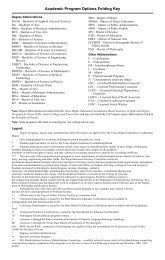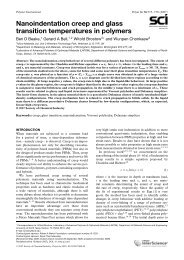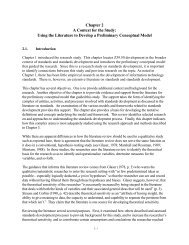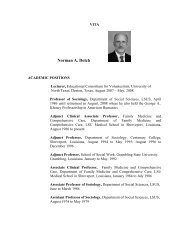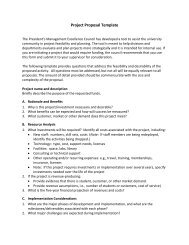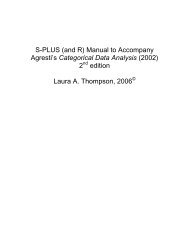Holmbeck, G. N. (1997). - Personal.kent.edu
Holmbeck, G. N. (1997). - Personal.kent.edu
Holmbeck, G. N. (1997). - Personal.kent.edu
- No tags were found...
You also want an ePaper? Increase the reach of your titles
YUMPU automatically turns print PDFs into web optimized ePapers that Google loves.
604 HOLMBECKterms "mediating" and "moderating" interchangeably. Baronand Kenny (1986) provide some examples of this problem fromthe social psychology literature. More recently, Davies and Cummings(1995) appear to be using the terms interchangeablywhen discussing Grych and Fincham's (1990) model of childadjustment to marital conflict. On the one hand, Davies andCummings (1995) maintain that Grych and Fincham (1990)"have proposed that intraindividual factors, including cognitiveprocesses.., and emotional states, interact with the characteristicsof marital conflict to shape its impact" (p. 677), whichimplies that Grych and Fincham have proposed a moderationalmodel. Later in the same article, Davies and Cummings (1995)argued that Grych and Fincham have emphasized "the delineationof cognitive processes mediating the impact of marital conflicton children . . ." (p. 678). Thus, Davies and Cummingshave identified the same process as both a moderated effect anda mediated effect (see Hanson, Henggeler, & Burghen, 1987,and Mullins et al., 1991, for similar examples).Inconsistencies Between Terminology andConceptualizationTwo types of inconsistencies are highlighted in this section:(a) the term "mediator" is used, but the variable in questionis not conceptualized as a mediator or a moderator, and (b) theterm "mediator" is used, but the variable is conceptualized asa moderator.As an example of the first type of inconsistency, Thompsonand colleagues present a diagrammatic model that includes"mediational processes" (e.g., cognitive processes, methods ofcoping, family functioning; Thompson, Gil, Abrams, & Phillips,1992; Thompson et al., 1993; Thompson, Gustafson, & Gil,1995; Thompson, Gustafson, Hamlett, & Spock, 1992), but thevariables contained within these components of the model arenot conceptualized as mediators, at least as the authors havedescribed them in their published work. 2 Instead, Thompson etal. (1993) argued that "child cognitive processes, child paincopingstrategies, and maternal psychological adjustment willaccount for independent and significant increments in the variancein child adjustment over and above that accounted for byillness and demographic parameters" (p. 469). This is a statementof neither mediation nor moderation; rather, this hypothesisis a statement of relative predictive utility. In an example fromthe child-clinical literature, Cummings et al. (1994) used children'sappraisals of marital conflict and perceived coping efficacyas mediators between marital conflict and child adjustment.Despite the use of the term "mediation," these investigatorshave not made a clear case for how their variables could servea mediational function (i.e., they do not present a model in theA ---, B ~ C format, either in written or diagrammatic form).As an example of the second type of inconsistency (i.e.,the term "mediation" is used but the variable appears to beconceptualized as a moderator), Ireys et al. (1994) examined"perceived impact" as a variable that mediates associationsbetween several illness parameters and psychological symptoms.Although the analyses appear to provide accurate tests of mediationaleffects, Ireys et al. (1994) have implied that perceivedimpact may serve a moderating function:Some young adults with a chronic health condition, for example,view their disorder as negatively affecting most aspects of theirlives and may therefore report high levels of psychological symptomatology;others, with similar conditions, may view their conditionin a less burdensome light... How a young adult perceivesthat a condition has influenced a developmentally important task• . . appears to alter significantly some of the associations betweenspecific condition characteristics and mental health status. (pp. 206,219)These statements appear to describe a moderated effect (ratherthan the intended mediational effect); an individual's conditionis more likely to have a negative effect on outcome when theillness is perceived in a certain way (see Barakat & Linney,1992, for a similar example).In an example from the child-clinical literature, Grych andFincham (1990) have provided a cognitive-contextual frameworkfor understanding children's responses to marital conflictand emphasize "the role of cognitive factors in mediating therelationship between marital conflict and maladjustment" (p.277). On the other hand, the examples they provide suggestthat they are discussing a moderated effect. For example, indiscussing causal attributions, they suggest that "a child whoviews him or herself as a cause of parental conflict is likely toexperience more distress than a child who attributes the causeof conflict to one or both parents or to outside circumstances"(p. 282). This statement implies that the effect of marital conflicton adjustment is moderated by the child's attributions insofaras marital conflict is expected to have an impact on adjustmentonly under certain conditions (see O'Brien et al., 1995;Rudolph, Dennig, & Weisz, 1995, for similar examples).Inconsistencies Between Terminology and StatisticalAnalysesThree types of inconsistencies are highlighted in this section:(a) The term "mediation" is used, but the analyses test neithermediation nor moderation, (b) the term "moderation" is used,but the analyses test neither mediation nor moderation, and (c)a lack of clarity in discussing implications of statistical results.Although Thompson and his colleagues use the term "mediator,"their data analyses do not test for the presence of mediationaleffects (see also Varni, Wilcox, & Hanson, 1988 ). Consistentwith the predictive utility hypothesis discussed above,Thompson et al. typically use hierarchical regression strategiesto assess differential predictive utility rather than mediationaleffects (e.g., Thompson et al., 1993). On the other hand,Thompson et al. would probably not advance mediationalhypotheses (as defined here), given their a priori expectationthat disease parameters are not likely to be significantly associatedwith adjustment outcomes (Thompson et al., 1993). Similarinconsistencies have emerged in the child-clinical literature(Cummings et al., 1994; O'Brien et al., 1995).A related statistical concern is that some investigators have2 Thompson and his colleagues have not used the phrase "mediationalprocesses" in recent diagrammatic versions of their model (e.g., Thompson,Gil, Gustafson, et al., 1994; Thompson & Gustafson, 1996; Thompson,Gustafson, George, & Spock, 1994; Wallander & Thompson, 1995).On the other hand, the figure that they use continues to represent amediational model, and they continue to use the term mediate in theirwritings (e.g., Thompson & Gustafson, 1996).




